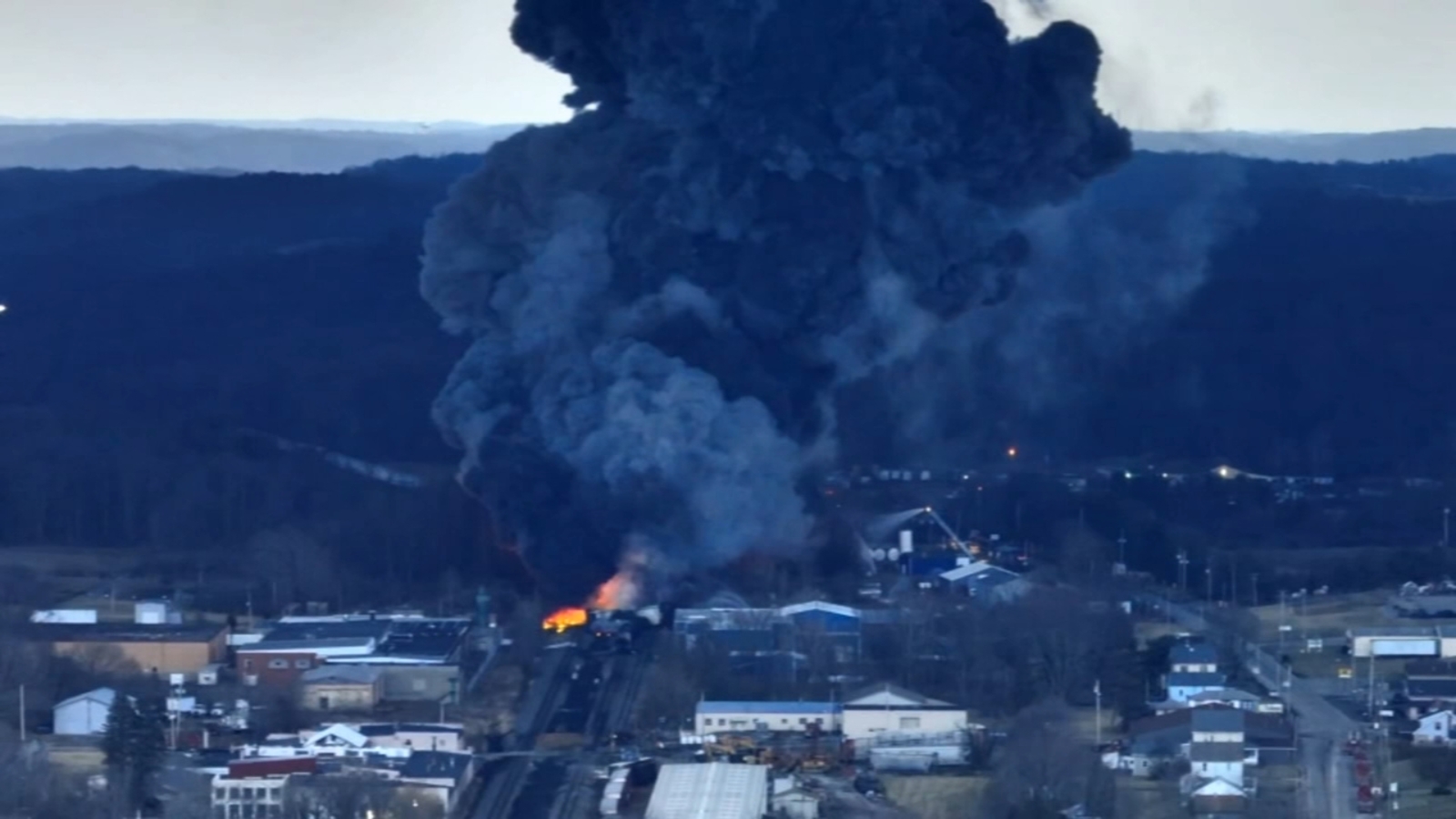Ohio Train Derailment: Assessing The Long-Term Effects Of Toxic Chemical Exposure In Buildings

Table of Contents
Assessing the Extent of Building Contamination
Determining the extent of contamination in buildings following the Ohio train derailment is crucial for mitigating long-term health risks. This requires a multi-pronged approach encompassing air, water, and soil quality assessments.
Air Quality Monitoring and Analysis
Air quality monitoring inside and around buildings is paramount. This involves testing for specific chemicals released during the derailment, such as vinyl chloride and butyl acrylate, along with other volatile organic compounds (VOCs).
- Methods used for air sampling: Passive and active air sampling techniques, utilizing specialized equipment to collect air samples for laboratory analysis.
- Detection limits: Utilizing sensitive analytical methods to detect even low levels of contaminants, ensuring accurate assessment of exposure risks.
- Interpretation of results: Expert interpretation of air quality data is crucial to determine the extent of contamination and potential health risks.
- Ongoing monitoring needs: Continuous air quality monitoring is essential to track the persistence of VOCs and ensure the effectiveness of any remediation efforts. The volatility of some chemicals means that initial testing may not reveal long-term contamination issues.
The persistence of VOCs in building materials, such as carpets, insulation, and drywall, presents a significant concern. These materials can act as reservoirs, releasing chemicals into the air over time, leading to prolonged exposure for residents.
Water Contamination Assessment
Assessing water sources is crucial. Contamination could stem from direct contact with spilled chemicals, leaching from contaminated soil, or through the municipal water supply.
- Testing for chemical contamination in well water: Private wells in the area require thorough testing for vinyl chloride, butyl acrylate, and other released chemicals.
- Testing for chemical contamination in municipal water: Even if the municipal water supply is deemed safe, ongoing monitoring is vital to ensure the absence of contamination.
- Potential for leaching into groundwater: The potential for chemicals to leach into groundwater and contaminate drinking water supplies over the long term is a serious concern.
The long-term implications of water contamination for residents' health are significant, potentially leading to various health problems if contaminated water is consumed or used for bathing.
Soil Contamination and its Impact on Buildings
Soil contamination around buildings can lead to vapor intrusion, the migration of volatile chemicals from the soil into indoor air.
- Soil sampling techniques: Specialized techniques are required to collect representative soil samples from around buildings.
- Analysis of contaminant levels: Laboratory analysis determines the concentration of various chemicals in the soil samples.
- Risk assessment for vapor intrusion: Modeling and simulations are used to assess the risk of vapor intrusion and potential indoor air contamination.
Soil contamination can persist for years, even decades, continuing to impact indoor air quality and posing long-term health risks.
Potential Long-Term Health Effects of Exposure
Exposure to the toxic chemicals released during the Ohio train derailment poses various long-term health risks.
Respiratory Illnesses and Conditions
Inhalation of chemicals like vinyl chloride and butyl acrylate can cause a range of respiratory problems.
- Asthma: Increased risk of developing or exacerbating asthma, due to the irritating effects of the chemicals on the lungs.
- Bronchitis: Inflammation and irritation of the bronchial tubes can lead to chronic bronchitis.
- Lung cancer: Some of the released chemicals are known carcinogens, increasing the risk of lung cancer.
- Other respiratory complications: Other conditions like emphysema, pulmonary fibrosis, and chronic obstructive pulmonary disease (COPD) may be potential long-term outcomes.
The long-term nature of these effects necessitates ongoing respiratory health monitoring for all residents in the affected area.
Neurological and Cardiovascular Impacts
Exposure to certain chemicals can also have significant neurological and cardiovascular consequences.
- Headaches: Frequent or severe headaches can be a sign of chemical exposure and related neurological issues.
- Dizziness: Chemical exposure may cause dizziness, disorientation, and balance problems.
- Cognitive impairment: Some chemicals can negatively impact cognitive function, potentially leading to memory loss and difficulty concentrating.
- Heart problems: Cardiovascular issues, such as irregular heartbeat or hypertension, can occur following chemical exposure.
Comprehensive health screenings are necessary to identify and address these potential long-term effects.
Other Health Concerns
Beyond respiratory and cardiovascular issues, there are other potential long-term health concerns associated with exposure to the chemicals released in the derailment.
- Reproductive health issues: Exposure to certain chemicals can have adverse effects on reproductive health in both men and women.
- Developmental problems in children: Exposure during pregnancy or early childhood may lead to developmental problems in children.
- Increased cancer risks: Several chemicals released during the derailment are known or suspected carcinogens, raising concerns about increased cancer risk.
Ongoing research and epidemiological studies are essential to fully understand the long-term implications.
Remediation and Mitigation Strategies
Addressing the contamination resulting from the Ohio train derailment requires a comprehensive remediation and mitigation strategy.
Cleaning and Decontamination of Buildings
Removing contamination from buildings necessitates professional intervention and specialized techniques.
- Air filtration systems: High-efficiency particulate air (HEPA) filters can help remove airborne contaminants.
- Specialized cleaning techniques: Specialized cleaning methods, such as wet-wiping and steam cleaning, can be used to remove contaminants from surfaces.
- Removal of contaminated materials: In cases of severe contamination, it may be necessary to remove and replace contaminated building materials.
Utilizing certified professionals with expertise in environmental remediation is critical to ensure the effectiveness and safety of the cleanup process.
Long-Term Monitoring and Surveillance
Continuous monitoring of air, water, and soil quality is essential to track the effectiveness of remediation efforts and ensure long-term public health.
- Regular testing schedules: Regular testing should be conducted to assess contaminant levels over time.
- Data analysis and reporting procedures: Data analysis should be conducted to identify trends and potential problems, with transparent reporting to the public.
- Community engagement and transparency: Open communication and community engagement are critical to building trust and ensuring the effectiveness of monitoring programs.
This continuous monitoring will help identify any remaining risks and inform further remediation efforts.
Support and Resources for Affected Residents
Providing comprehensive support and resources to affected residents is vital for their physical and mental well-being.
- Medical assistance: Access to medical care, including specialized testing and treatment, is crucial for those experiencing health problems.
- Psychological support: Mental health services are essential to address the stress and anxiety experienced by residents.
- Legal aid: Legal assistance is important for residents to navigate potential legal challenges related to the derailment.
- Financial assistance programs: Financial support may be needed for residents facing economic hardship due to the derailment.
Ensuring access to these resources is critical to the long-term recovery and well-being of the affected community.
Conclusion
The Ohio train derailment has created a complex and challenging situation regarding long-term health risks associated with building contamination. Thorough assessment of building contamination from toxic chemical exposure, comprehensive health monitoring, and effective remediation strategies are vital for mitigating these risks. Continued research, transparent communication, and sustained support for affected residents are crucial in addressing the long-term effects of this disaster. Understanding the potential long-term consequences of the Ohio train derailment and taking proactive steps toward remediation are essential to protect public health and ensure the safety of affected communities. If you suspect your building has been affected by the Ohio train derailment and toxic chemical exposure, seek professional assessment and remediation services immediately.

Featured Posts
-
 E Bay Listings For Banned Chemicals Section 230 Protection Challenged
Apr 24, 2025
E Bay Listings For Banned Chemicals Section 230 Protection Challenged
Apr 24, 2025 -
 Subsystem Issue Forces Blue Origin To Postpone Rocket Launch
Apr 24, 2025
Subsystem Issue Forces Blue Origin To Postpone Rocket Launch
Apr 24, 2025 -
 Tesla Q1 Earnings A Deep Dive Into The Recent Profit Decrease
Apr 24, 2025
Tesla Q1 Earnings A Deep Dive Into The Recent Profit Decrease
Apr 24, 2025 -
 Utac Chip Tester Chinese Buyout Firm Explores Sale Options
Apr 24, 2025
Utac Chip Tester Chinese Buyout Firm Explores Sale Options
Apr 24, 2025 -
 Legal Battle Over Banned Chemicals Sold On E Bay Section 230 Implications
Apr 24, 2025
Legal Battle Over Banned Chemicals Sold On E Bay Section 230 Implications
Apr 24, 2025
